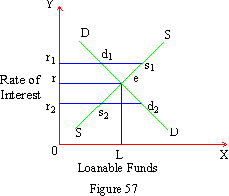Borrowing and lending are capital
transactions. Savings or bank credits are supplied as loanable funds.
Borrowers pay the extra charges of interest or discount for the
use of loanable funds. Therefore the rate of interest is the price
of borrowing loanable funds. Matters like the interest rate being
positive, or then how high (or low) an interest should be charged
are determined in the same manner like other commodity prices. It
is the supply of savings and the demand for loanable funds which
together determine the rate of interest. If the number of savers
and their amount of saving exceeds the needs of the borrowers then
the rate of interest will be relatively low. But if the loanable
funds supplied are smaller in size than the needs of the borrowers
the rate of interest will be relatively higher. Demand for funds
borrowed increases with every fall in the rate of interest. Therefore
supply of savings or loanable funds is an upward sloping curve.
Demand and supply schedules in the capital market together determine
the rate of interest.

In Figure 57 DD is the downward sloping demand
curve for loanable funds. The supply curve of loanable funds SS
is upward sloping showing an increased savings effort with every
rise in the rate of interest. The two curves have intersected at
point e which is an equilibrium position in the capital market.
At point e the quantity of loanable funds exchanged is L
and the rate of interest is r. If the rate of interest is somewhat
higher, for instance, like r1,
then supply of saving s1
will exceed demand for loanable funds d1
(s1
> d1).
Therefore some savers will try to push down the rate of interest
and move in the direction of the point e. On the other hand,
if the actual rate of interest is lower (r2)
then the demand for loanable funds, d2,
exceeds supply of savings s2
(d2
> s2). Some of the
borrowers will then remain unsatisfied and will try to push the
rate of interest upwards by moving in the direction of the point
e. Thus r is the only stable equilibrium rate of interest.
 Home
Home
Tidak ada komentar:
Posting Komentar
Terima Kasih